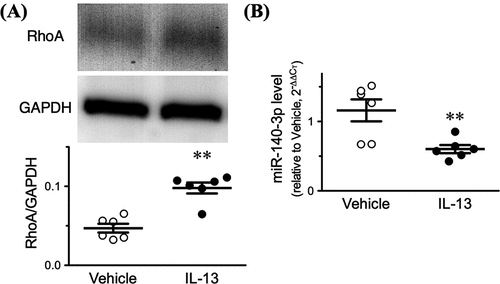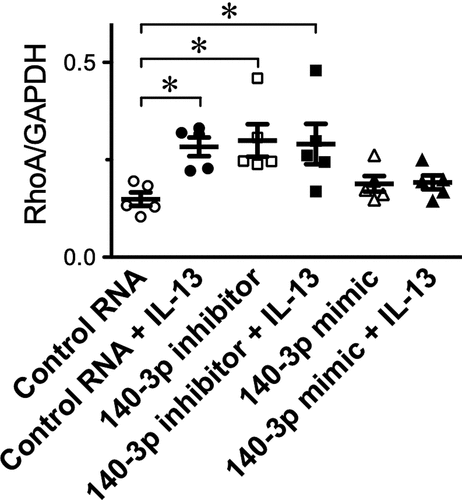Figures & data
Figure 1. Interleukin-13 (IL-13) causes an up-regulation of RhoA protein concurrently with a down-regulation of miR-140-3p in cultured human bronchial smooth muscle cells. Cells were treated with IL-13 (100 ng/mL) or its vehicle for 24 hours, and proteins and total RNAs including miRNAs were extracted. (a) (Upper panel) Representative Western blots. The relative expression of RhoA to glyceraldehyde 3-phosphate dehydrogenase (GAPDH) proteins in each sample was calculated and the data are summarized in lower panel. (b) miR-140-3p expression level determined by quantitative real-time reverse transcriptase-polymerase chain reaction. The relative gene expressions of miR-140-3p to U6 snRNA was calculated by the 2−ΔΔCT methods. Results are presented as mean ± S.E. from 6 independent experiments. **p < 0.01 versus Vehicle group by unpaired Student’s t-test

Figure 2. Effects of miR-140-3p inhibitor and mimic on the interleukin-13 (IL-13)-induced up-regulation of RhoA protein in cultured human bronchial smooth muscle cells. Cells were transfected with a non-targeting 20–25 nt RNA (Control RNA), a miR-140-3p inhibitor (140–3p inhibitor), or a miR-140-3p mimic (140–3p mimic), and then treated with IL-13 (100 ng/mL) or its vehicle 48 hours after the transfection. Twenty-four hours after the IL-13 treatment, total protein samples were prepared and immunoblot analyses were performed. The relative expression of RhoA to glyceraldehyde 3-phosphate dehydrogenase (GAPDH) in each sample was calculated and the data are summarized. Results are presented as mean ± S.E. from 5 independent experiments. *p < 0.05 versus Control RNA only group by Bonferroni/Dunn test. Note that the RhoA up-regulation induced by IL-13 (Control RNA + IL-13 group) was inhibited by the transfection of miR-140-3p mimic (140–3p mimic + IL-13 group)

